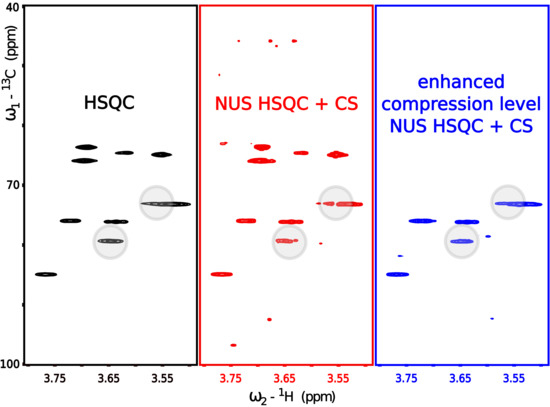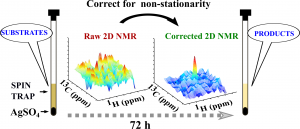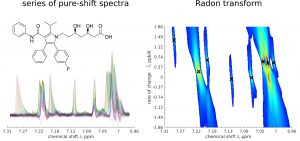New Article in Sensors
02 March 2020Enhancing Compression Level for More Efficient Compressed Sensing and Other Lessons from NMR Spectroscopy

Dariusz Gołowicz, Paweł Kasprzak and Krzysztof Kazimierczuk*
Modern nuclear magnetic resonance spectroscopy (NMR) is based on two- and higher-dimensional experiments that allow the solving of molecular structures, i.e., determine the relative positions of single atoms very precisely. However, rich chemical information comes at the price of long data acquisition times (up to several days). This problem can be alleviated by compressed sensing (CS)—a method that revolutionized many fields of technology. It is known that CS performs the most efficiently when measured objects feature a high level of compressibility, which in the case of NMR signal means that its frequency domain representation (spectrum) has a low number of significant points. However, many NMR spectroscopists are not aware of the fact that various well-known signal acquisition procedures enhance compressibility and thus should be used prior to CS reconstruction. In this study, we discuss such procedures and show to what extent they are complementary to CS approaches. We believe that the survey will be useful not only for NMR spectroscopists but also to inspire the broader signal processing community.
New Article in Progress in NMR Spectroscopy
30 September 2019Fast time-resolved NMR with non-uniform sampling

Dariusz Gołowicz, Paweł Kasprzak, Vladislav Orekhov and Krzysztof Kazimierczuk*
NMR spectroscopy is a versatile tool for studying time-dependent processes: chemical reactions, phase transitions or macromolecular structure changes. However, time-resolved NMR is usually based on the simplest among available techniques – one-dimensional spectra serving as “snapshots” of the studied process. One of the reasons is that multidimensional experiments are very time-expensive due to costly sampling of evolution time space. In this review we summarize efforts to alleviate the problem of limited applicability of multidimensional NMR in time-resolved studies. We focus on techniques based on sparse or non- uniform sampling (NUS), which lead to experimental time reduction by omitting a significant part of the data during measurement and reconstructing it mathematically, adopting certain assumptions about the spectrum. NUS spectra are faster to acquire than conventional ones and thus better suited to the role of “snapshots”, but still suffer from non-stationarity of the signal i.e. amplitude and frequency variations within a dataset. We discuss in detail how these instabilities affect the spectra, and what are the optimal ways of sampling the non-stationary FID signal. Finally, we discuss related areas of NMR where serial experiments are exploited and how they can benefit from the same NUS-based approaches.
New Article in Analytical Chemistry
08 August 2019Non-stationary 2D NMR – a novel method for studying reaction mechanism in situ.

Ewa K. Nawrocka, Paweł Kasprzak, Katarzyna Zawada, Jarosław Sadło, Wojciech Grochala, Krzysztof Kazimierczuk* and Piotr J. Leszczyński*
Nuclear magnetic resonance spectroscopy (NMR) is a versatile tool of chemical analysis allowing to determine structures of molecules with atomic resolution. Particularly informative are two-dimensional (2D) experiments, that directly identify atoms coupled by chemical bonds or a through-space interaction. Thus, NMR could potentially be powerful tool to study reactions in situ and explain their mechanisms. Unfortunately, 2D NMR is very time-consuming and thus often cannot serve as a ”snapshot” technique for in situ reaction monitoring. Particularly difficult is the case of spectra, in which resonance frequencies vary in the course of reaction. This leads to resolution and sensitivity loss, often hindering the detection of transient products. In this paper we introduce a novel approach to correct such non-stationary 2D NMR signals and raise the detection limits over 10 times. We demonstrate success of its application for studying the mechanism of the reaction of AgSO4-induced synthesis of diphenylmethane-type compounds. Several reactions occur in the studied mixture of benzene and toluene, all with rather low yield and leading to compounds with similar chemical shifts.Nevertheless, with the use of a proposed 2D NMR approach we were able to describe complex mechanisms of diphenylmethane formation involving AgSO4-induced toluene deprotonation and formation of benzyl carbocation, followed by nucleophylic attacks.
New Article in Physical Chemistry Chemical Physics
Quick temperature-swept pure-shift NMR: case of solvent effects in atorvastatin

Małgorzata Rytel, Paweł Kasprzak, Piotr Setny and Krzysztof Kazimierczuk
Pure-shift NMR experiments provide highly resolved spectra, that could be perfect for precise monitoring of chemical shift variations under different conditions, such as temperature or concentration. However, their sensitivity is quite low and signal sampling is time-consuming, leading to long experimental times and making such serial acquisition problematic. In this paper we present a new method of NMR spectroscopy improving the speed and sensitivity of serial pseudo-two-dimensional pure-shift experiments. The example of variable-temperature study of atorvastatin reveals the potential of the method in verifying the theoretical predictions of solvent-dependent spectral effects.

